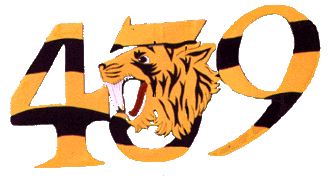|
History
of
 Squadron Squadron
  
Chapter
VI
Winter in the Netherlands
November 1944 January
1945
On the 7th, another wretched day with a wicked cross wind blowing over the runway, F/L Burgess's formation cut the rails between Goch and Weeze after finding their
original target blotted out by low clouds.
After three cloudy, rainy days there was a slight
improvement on the 11th which enabled the squadron to get in three shows against targets in Holland. The first mission was a long range job to knock out the canal gates at Sneek, far to the north in Friesland, in
hope of impairing the enemy's use of the network of canals connected with Sneeker Meer. Eight pilots of No. 439, led by F/L Jimmy Hogg, were detailed for this important mission with a fighter cover of four Typhoons from No. 440 and four more from No. 168 as
anti flak escort.
|
Intentionally
left blank
|

F/0 J.G.
Fraser
Photo
439 Sqn Archives
|
On approaching the target the bombers spread out
in pairs, leaving a sufficient interval to allow the 11 second delay bombs to explode without endangering the aircraft coming in behind. From 4500 feet they dived to the deck, released their 1000 lb. missiles and broke away to port. A few missed, but the majority hit the mark and definitely damaged the gates.
One pair of bombs exploded prematurely and caused a glycol leak in F/0 J.G. Fraser' s aircraft which forced him to land about eight miles south of the target. After reaching the ground Johnny called on the R/T to say that he was O.K. and
"would see us
sometime".
|
|
When Johnny Fraser
forced landed after the attack on the canal at Sneek he told his comrades that he hoped to
"see them
sometime". It was several months before he was able to and in the interval he had quite an interesting time. His
crash-landing in an open field near Heerenveen had been effected without injury to himself or much damage to his aircraft
(1) and, after destroying some equipment and throwing other items into the canal, he took to his heels to avoid people who were approaching. A mile away he took cover in tall grass in a ditch by the roadside where two civilians,
who had seen him go into hiding, brought him a jacket. With them he moved to a small shack where he remained until dark. Then he was taken to a farmhouse some miles away and, after two days and nights indoors, moved to another farm in the vicinity. Here he remained
until March 1945. (2)
For the first two months Johnny had to remain indoors; then he was allowed to go out to help the hired men with the farm work. The Dutch farmer (who spoke English) treated him very well and gave him ample food, although Fraser found the steady diet of potatoes, porridge and bread became monotonous. Late in March German searches for members of the underground forced Johnny to vacate his comfortable Dutch home, but his friends found shelter for him at other farms until on 14 April he was able to reach a
Canadian Army reconnaissance unit.
(1) Members of the Dutch underground subsequently made the aircraft
"useless".
(2) At the end of November the squadron learned, via the underground "grapevine", that Fraser was in friendly hands in Holland.
  
Copyright
©1998-2016 Michael T. Melnick. All rights reserved
the
unofficial homepage of  Tiger
Squadron Tiger
Squadron
.
.
|
|